Pelvic Floor Retraining for Stress Urinary Incontinence

© Peter Dazeley | Getty Images
A cough, a sneeze, or even laughter can cause the involuntary loss of urine. Some people might think an occasional little leak may not be a big deal, but frequent leakage can lead to visible wetness, odor, and may be a sign of an underlying problem.
This article focuses on the two main types of urinary incontinence (UI): stress UI, in which urine leaks in association with physical exertion (e.g., cough, exercise), and urge UI, in which urine leaks in association with a sudden compelling desire to void (i.e., unable to make it to the bathroom on time).
Common Cause: Weak Pelvic Floor
UI is a symptom, not a disease, and can be caused by many factors. Often, it signals underactive/weak pelvic floor muscles, which can be readily addressed by pelvic floor retraining. Weak pelvic floor muscles can cause all kinds of problems. According to Valerie Lapeña, a UCLA Health physical therapist, underactive pelvic floor muscles can lead to urinary or fecal incontinence, pelvic organ prolapse, and erectile dysfunction.
“Shaped like a hammock, pelvic floor muscles span the base of the pelvis. When riding a bicycle, we can feel these muscles contact the saddle,” explains Lapeña. “As part of the core system, these muscles support the bladder, uterus, vagina, and rectum. Equally important, these muscles play a role in urinary and anal continence, voiding, defecation, breathing, sexual function, and low back/trunk stabilization.”
Both men and women of any age can have UI. However, it is more common in older people and women. Not being able to make it to the bathroom on time can have a domino effect on health. It can cause stress, anxiety, and depression. People may become socially isolated, fearing accidents in public. It can also disrupt physical fitness, keeping people from the gym due to concerns of wetness and odor. Left unaddressed, UI can negatively impact sexual intimacy as well.
Other Causes of UI

© Sebastian Kaulitzki/Science Photo Library | Getty Images
Pelvic floor physical therapists specialize in teach you how to you strengthen pelvic muscles which can help treat bothersome urinary, bowel and sexual symptoms.
Though it’s a common condition typically caused by weak pelvic floor muscles, sometimes UI can be a symptom of other medical problems. This why it’s especially wise to discuss the issue with your physician.
UI can be caused by a urinary tract infection, or more seriously (and more rarely) cancer of the pelvic region. Damage to nerves that control the bladder from diseases such as multiple sclerosis, diabetes, and Parkinson’s disease can cause incontinence. In women the condition can occur from pelvic organ prolapse, which occurs when pelvic organs (such as the bladder, rectum, or uterus) shift out of their normal place into the vagina or anus, which may cause urine to leak. Most incontinence in men is related to the prostate gland.
Male incontinence may be caused by an injury or damage to prostate nerves or muscles from surgery, or a prostate gland enlarged by benign prostatic hyperplasia, a condition in which the prostate grows as men age. UI is a common symptom after prostate surgery, but it can be reduced with pelvic floor rehab.
Pelvic Floor Retraining for UI
Upon proper diagnosis, pelvic floor muscle retraining is typically the first-line treatment for UI. “When patients are diagnosed with underactive pelvic floor muscles, performing strength training such as Kegel exercises (isolated shortening contraction of the pelvic floor muscles) can be helpful,” says Lapeña. “In general, pelvic floor muscles are considered skeletal muscles and benefit from the same strength training principles as other skeletal muscles, for example, the biceps. Unlike other skeletal muscles in the body, however, the pelvic floor muscles are dually innervated by the somatic and autonomic nervous systems, which means we have both involuntary and voluntary control over these muscles.”
Results Timeline
Lapeña says that functional changes, improvement in the strength of pelvic floor muscles, and reduction in bothersome symptoms of incontinence may occur as soon as eight weeks of pelvic floor exercises. “The amount of time to make lasting changes depends on adherence to the home program and other health and lifestyle factors,” she explains. “The home exercise program is customized based on the patient’s current strength and endurance at the time of the pelvic floor muscle exam.”
Research shows that UI can affect physical and mental health as well as quality of life, yet a lot of people forgo consulting with a physician. Though it may be embarrassing to discuss UI, primary care physicians, urologists, and gynecologists are well versed in the subject. Not all physical therapists can treat UI; therefore, seek a referral to a pelvic floor physical therapist.
The post Pelvic Floor Retraining for Stress Urinary Incontinence appeared first on University Health News.
Read Original Article: Pelvic Floor Retraining for Stress Urinary Incontinence »

